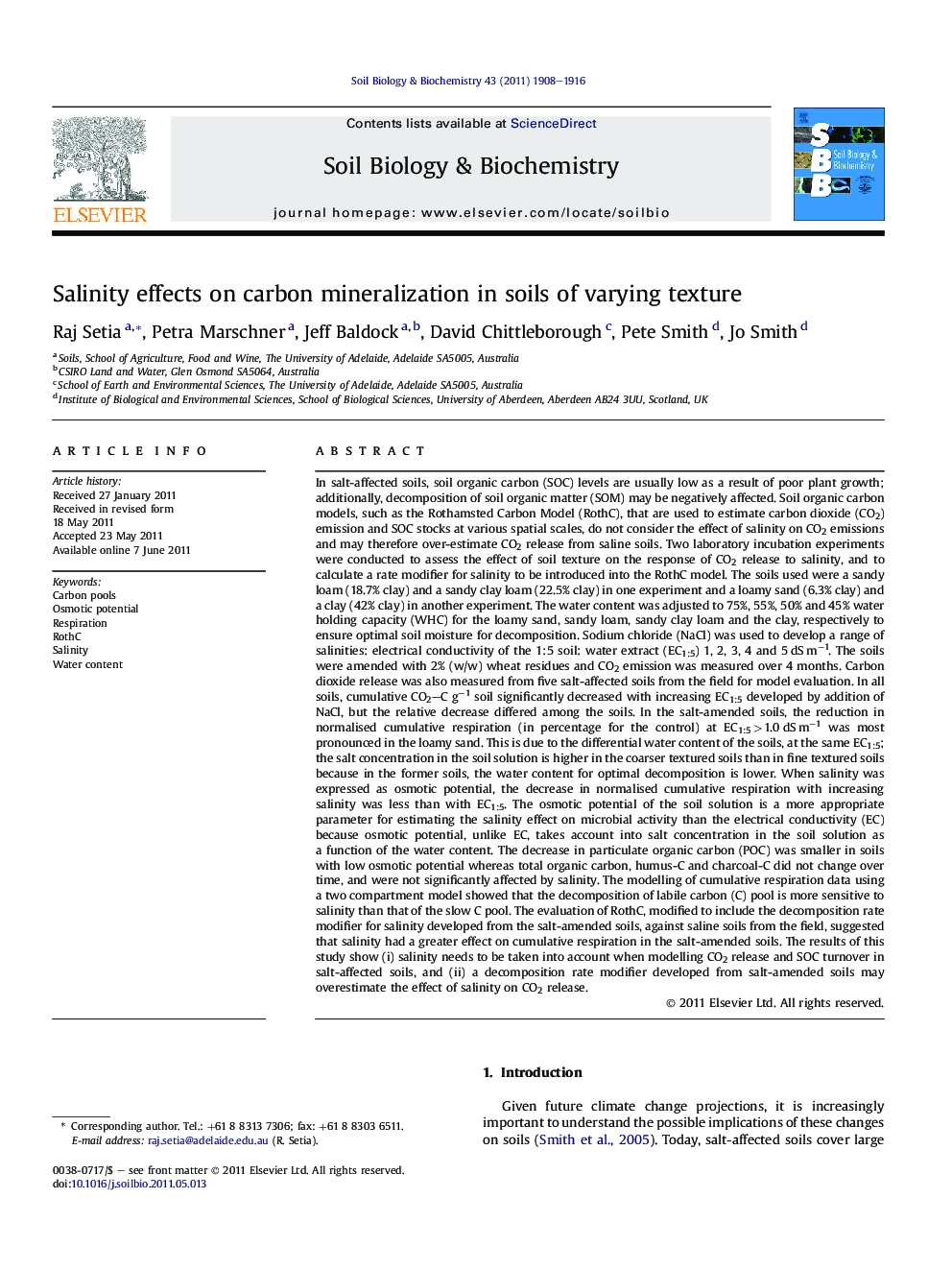| کد مقاله | کد نشریه | سال انتشار | مقاله انگلیسی | نسخه تمام متن |
|---|---|---|---|---|
| 2025251 | 1069989 | 2011 | 9 صفحه PDF | دانلود رایگان |

In salt-affected soils, soil organic carbon (SOC) levels are usually low as a result of poor plant growth; additionally, decomposition of soil organic matter (SOM) may be negatively affected. Soil organic carbon models, such as the Rothamsted Carbon Model (RothC), that are used to estimate carbon dioxide (CO2) emission and SOC stocks at various spatial scales, do not consider the effect of salinity on CO2 emissions and may therefore over-estimate CO2 release from saline soils. Two laboratory incubation experiments were conducted to assess the effect of soil texture on the response of CO2 release to salinity, and to calculate a rate modifier for salinity to be introduced into the RothC model. The soils used were a sandy loam (18.7% clay) and a sandy clay loam (22.5% clay) in one experiment and a loamy sand (6.3% clay) and a clay (42% clay) in another experiment. The water content was adjusted to 75%, 55%, 50% and 45% water holding capacity (WHC) for the loamy sand, sandy loam, sandy clay loam and the clay, respectively to ensure optimal soil moisture for decomposition. Sodium chloride (NaCl) was used to develop a range of salinities: electrical conductivity of the 1:5 soil: water extract (EC1:5) 1, 2, 3, 4 and 5 dS m−1. The soils were amended with 2% (w/w) wheat residues and CO2 emission was measured over 4 months. Carbon dioxide release was also measured from five salt-affected soils from the field for model evaluation. In all soils, cumulative CO2–C g−1 soil significantly decreased with increasing EC1:5 developed by addition of NaCl, but the relative decrease differed among the soils. In the salt-amended soils, the reduction in normalised cumulative respiration (in percentage for the control) at EC1:5 > 1.0 dS m−1 was most pronounced in the loamy sand. This is due to the differential water content of the soils, at the same EC1:5; the salt concentration in the soil solution is higher in the coarser textured soils than in fine textured soils because in the former soils, the water content for optimal decomposition is lower. When salinity was expressed as osmotic potential, the decrease in normalised cumulative respiration with increasing salinity was less than with EC1:5. The osmotic potential of the soil solution is a more appropriate parameter for estimating the salinity effect on microbial activity than the electrical conductivity (EC) because osmotic potential, unlike EC, takes account into salt concentration in the soil solution as a function of the water content. The decrease in particulate organic carbon (POC) was smaller in soils with low osmotic potential whereas total organic carbon, humus-C and charcoal-C did not change over time, and were not significantly affected by salinity. The modelling of cumulative respiration data using a two compartment model showed that the decomposition of labile carbon (C) pool is more sensitive to salinity than that of the slow C pool. The evaluation of RothC, modified to include the decomposition rate modifier for salinity developed from the salt-amended soils, against saline soils from the field, suggested that salinity had a greater effect on cumulative respiration in the salt-amended soils. The results of this study show (i) salinity needs to be taken into account when modelling CO2 release and SOC turnover in salt-affected soils, and (ii) a decomposition rate modifier developed from salt-amended soils may overestimate the effect of salinity on CO2 release.
► Effect of soil texture on the response of CO2 release to salinity was assessed in incubation studies.
► At a given EC, relative respiration was higher in fine textured soils than coarse textured soils.
► The decrease in CO2 release in response to osmotic potential was less than with EC.
► A decomposition rate-modifier, developed from the salt amended soils, was included in the RothC model.
► The model overestimated the salinity effect on respiration of field-collected saline soils.
Journal: Soil Biology and Biochemistry - Volume 43, Issue 9, September 2011, Pages 1908–1916